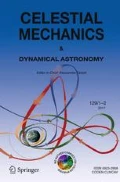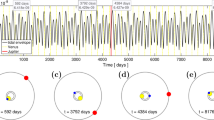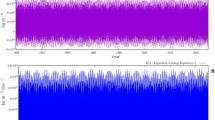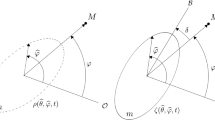Abstract
Tidal dissipation is the main driver of orbital evolution of natural satellites and a key point to understand the exoplanetary system configurations. Despite its importance, its quantification from observations still remains difficult for most objects of our own Solar System. In this work, we overview the method that has been used to determine, directly from observations, the tidal parameters, with emphasis on the Love number \(k_2\) and the tidal quality factor Q. Up-to-date values of these tidal parameters are summarized. Last, an assessment on the possible determination of the tidal ratio \(k_2/Q\) of Uranus and Neptune is done. This may be particularly relevant for coming astrometric campaigns and future space missions focused on these systems.



Similar content being viewed by others
References
Archinal, B.A., et al.: Report of the IAU working group on cartographic coordinates and rotational elements: 2009. Celest. Mech. Dyn. Astron. 109, 101–135 (2011)
Arlot, J.-E., Emelyanov, N.V.: The NSDB natural satellites astrometric database. Astron. Astrophys. 503, 631–638 (2009)
Crida, A., Charnoz, S.: Formation of regular satellites from ancient massive rings in the solar system. Science 338, 1196 (2012)
Cuk, M.: Recent Origin of Titan’s Orbital Eccentricity. American Astronomical Society, DDA meeting vol. 45, p. 301.01 (2014)
Gavrilov, S.V., Zharkov, V.N.: Love numbers of the giant planets. Icarus 32, 443–449 (1977)
Goldreich, P., Soter, S.: Q in the solar system. Icarus 5, 375–389 (1966)
Iess, L., et al.: The tides of Titan. Science 337, 457–459 (2012)
Jacobson, R.A.: The orbits of the Neptunian satellites and the orientation of the pole of Neptune. Astron. J. 137, 4322–4329 (2009)
Jacobson, R.A., Lainey, V.: Martian satellite orbits and ephemerides. Planet. Space Sci. 102, 35–44 (2014)
Konopliv, A.S., Yoder, C.F.: Venusian \(k_2\) tidal Love number from Magellan and PVO tracking data. Geophys. Res. Lett. 23, 1857–1860 (1996)
Konopliv, A.S., et al.: Mars high resolution gravity fields from MRO, Mars seasonal gravity, and other dynamical parameters. Icarus 211, 401–428 (2011)
Konopliv, A.S., et al.: The JPL lunar gravity field to spherical harmonic degree 660 from the GRAIL Primary Mission. J. Geophys. Res. (Planets) 118, 1415–1434 (2013)
Lainey, V.: A new dynamical model for the Uranian satellites. Planet. Space Sci. 56, 1766–1772 (2008)
Lainey, V., Tobie, G.: New constraints on Io’s and Jupiter’s tidal dissipation. Icarus 179, 485–489 (2005)
Lainey, V., et al.: Strong tidal dissipation in Io and Jupiter from astrometric observations. Nature 459, 957–959 (2009)
Lainey, V., et al.: New constraints on Saturn’s interior from Cassini astrometric data (2015). arXiv:1510.05870
Lemoine, F.G., et al.: High-degree gravity models from GRAIL primary mission data. J. Geophys. Res. (Planets) 118, 1676–1698 (2013)
Love, A.E.H.: Some Problems of Geodynamics. Cambridge University Press, Cambridge (1911)
Matson, D.L., et al.: Heat flow from Io. J. Geophys. Res. 86, 1664–1672 (1981)
Mazarico, E., et al.: The gravity field, orientation, and ephemeris of Mercury from MESSENGER observations after three years in orbit. J. Geophys. Res. (Planets) 119, 2417 (2014)
Moyer, T.D.: Mathematical formulation of the double-precision orbit determination program (DPDOP). Technical report 32-1527, National Aeronautics and Space Administration (1971)
Moyer, T.D.: Formulation for Observed and Computed Values of Deep Space Network Observables, p. 576. Wiley, Hoboken (2003)
Pavlis, D.E., et al.: GEODYN II System Description, vol. 1–5, Contractor Report. SGT Inc., Greenbelt, MD (2013)
Peters, C.F.: Numerical integration of the satellites of the outer planets. Astron. Astrophys. 104, 37–41 (1981)
Petit, G., Luzum, B.: IERS conventions. IERS Technical Note No. 36 (2010)
Ray, R.D., et al.: Detection of tidal dissipation in the solid Earth by satellite tracking and altimetry. Nature 381, 595–597 (1996)
Ray, R.D., et al.: Constraints on energy dissipation in the Earth’s body tide from satellite tracking and altimetry. Geophys. J. Int. 144, 471–480 (2001)
Robert, V., et al.: A new astrometric reduction of photographic plates using the DAMIAN digitizer: improving the dynamics of the Jovian system. Mon. Not. R. Astron. Soc. 415, 701–708 (2011)
Robert, V., et al.: A new astrometric measurement and reduction of USNO photographic observations of Phobos and Deimos: 1967–1997. Astron. Astrophys. 582, A36 (2015)
Sharpless, B.P.: Secular accelerations in the longitudes of the satellites of Mars. Astron. J. 51, 185–186 (1945)
Spencer, J.R., et al.: Cassini encounters Enceladus: background and the discovery of a south polar hot spot. Science 311, 1401–1405 (2006)
Veiga, C.H., et al.: Positions of Uranus and its main satellites. Astron. J. 125, 2714–2720 (2003)
Wahr, J.M.: Body tides on an elliptical, rotating, elastic and oceanless earth. Geophys. J. R. Astron. Soc. 64, 677–703 (1981)
Williams, J.G., et al.: Lunar interior properties from the GRAIL mission. J. Geophys. Res. (Planets) 119, 1546–1578 (2014)
Acknowledgments
V. L. is grateful to P. Rosenblatt, J. C. Marty and B. Noyelles for fruitful discussions. This work has been supported by the International Space Science Institute (ISSI), the Scientific Council of the Paris Observatory and the PNP (INSU/CNES).
Author information
Authors and Affiliations
Corresponding author
Rights and permissions
About this article
Cite this article
Lainey, V. Quantification of tidal parameters from Solar System data. Celest Mech Dyn Astr 126, 145–156 (2016). https://doi.org/10.1007/s10569-016-9695-y
Received:
Revised:
Accepted:
Published:
Issue Date:
DOI: https://doi.org/10.1007/s10569-016-9695-y




